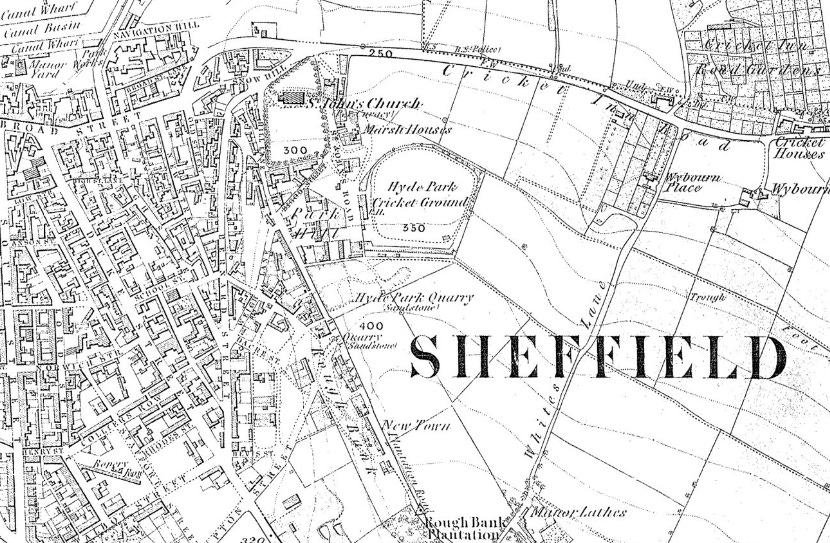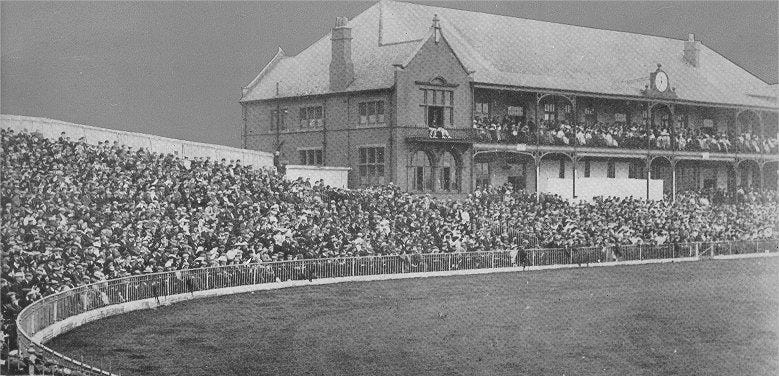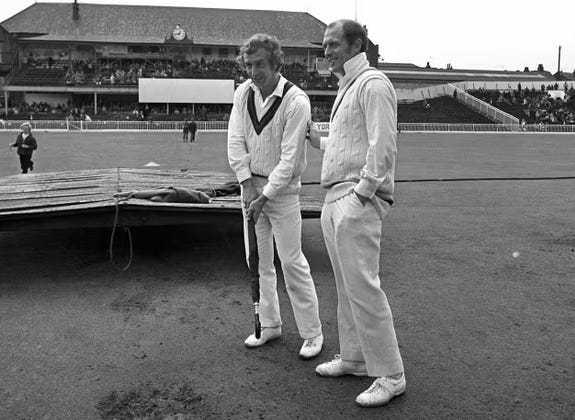(This post was originally issued to paid subscribers in February 2025)
Sport and social history are intrinsically linked, and especially so in the early developing days. Who played, who may have paid them, who build the stadia, who attended the events - they all tell the story of a time and place. Or, to put it another way, you don’t have to be a follower of a particular sport to find interest in the history and background. Sheffield is a big sporting city with a long and varied history. The ‘Home of Football’ campaign has been successful in bringing Sheffield’s sporting heritage into wider focus, and we also have the campaign to keep the World Snooker Championships here because there is a recognition of what hosting it does for the city. Having said that, before telling this story I declare an interest; in the words of the song, ‘I don’t like cricket - I love it’! Hopefully though this is as much about Sheffield as it is about cricket.
Cricket has been through many changes with regard to the laws of the game, something which is still happening today. In the 19th century the style of bowling progressively changed from underarm (literally ‘bowling’) to eventually the overarm style we know today. An important event in this evolution was a series of three matches in the summer of 1827 between the Sussex club and the rest of England, with one side bowling in the old style and the other trialling a new action. The three grounds that hosted these trials were Lords, Brighton (then home of the Sussex club), and Darnall. Yes, not only was Sheffield home to one of the most important grounds of the day, it was a now long lost ground in Darnall that had that honour - indeed it staged the first of the series in June 1827. This ground was called the ‘Darnall New Ground’ as it replaced a very short-lived older ground which had opened in 1822. A contemporary report described the Darnall ground in its heyday as the ‘finest in the Kingdom’.
‘The finest ground in the Kingdom’ - Darnall Cricket Ground in the 1820s
This match marked the high point for the Darnall Ground. The first Darnall Ground was said to have been nearby (it may even have been on virtually the same site) but suffered a near disaster during its first match between Sheffield and Nottingham in August 1822 when part of a stand collapsed and many spectators were injured - it being very fortunate that no-one was killed. The original owner, a Mr Steer, also built the new ground which opened in 1824, staging several representative games before hosting the 1827 trial match. The days of Darnall New Ground’s national fame were short-lived, and after 1829 no more major matches were staged there. It remained open space until 1859 when the site was used for Darnall Cemetery which remains in place to this day, stood back just off Darnall Road.
It appears that simple geography did for Darnall as a national cricket centre, as it was replaced almost immediately by a new ground closer to the old town centre at Hyde Park. This ground was first used in the summer of 1830 by the Sheffield Cricket Club, who were central to the story of cricket in the old town. They had used Darnall as their home ground, and they then moved to Hyde Park. An example of their impact can be seen in that the first recorded mentions of cricket in Leeds and Nottingham, two other great centres of the game, were visits from the Sheffield club to play games in Leeds in 1761 and Nottingham in 1771. Sheffield began to play games against county teams whilst at Hyde Park, and when they did so they sometimes styled themselves ‘Yorkshire’. It was this that led to the first officially recorded Yorkshire match, against Norfolk in September 1833, being held at the Hyde Park Ground.
Hyde Park Cricket Ground in 1855, then on the outskirts of the town
Hyde Park saw other notable occasions and firsts. In 1849 the first ‘Roses’ match between Yorkshire and Lancashire was held there, won by Yorkshire. It was the ground used by the touring ‘All England Eleven’ on their visits to the town, and the last recorded fixture at the ground in 1866 saw the first visit to Sheffield of WG Grace, then aged 18, who guest captained a ‘Nottingham and Sheffield’ side against the tourists. In his 1899 autobiography, ‘WG; Cricketing reminiscences and personal recollections’, Grace told of the long climb in a horse drawn cab to the top of the hill, presumably from either Wicker or Victoria stations; ‘I began to despair of the cab ever getting to the top’. Not the first newcomer to note Sheffield’s hills - and not a particularly big one either! Hyde Park was home to the Hallamshire Volunteer Rifle Corps for many years, and then the site of Hyde Park Greyhound Stadium from 1933 to 1980, before finally being developed over with blocks of flats.
Players from the Hallam and Staveley clubs at the Hyde Park Ground in 1858
As cricket ended at Hyde Park another ground was staging major matches in Sheffield; Bramall Lane was opened in 1855, another new home for the Sheffield Cricket Club. Land was provided by the Duke of Norfolk and was importantly located away from the smokier industrial parts of the town, in an area then largely undeveloped. When Yorkshire County Cricket Club was officially formed in 1863 Bramall Lane was their base, and remained so until 1893. The new county side ended the occasional practice of the Sheffield club representing Yorkshire, and an end to the club playing first class matches. The county headquarters moved to Headingley in Leeds in 1893; a sign of the future direction of travel for cricket in Yorkshire.
However, not long afterwards in 1902 came the high point of cricket in the by now city. For the first and only time Sheffield was to stage a test match; between England and Australia, held at Bramall Lane. Test cricket had begun in 1880, and for eighteen years only three grounds in England hosted games; Lords, The Oval, and Old Trafford. In 1899 two new grounds, Trent Bridge and Headingley, were added with some success, prompting a further expansion for 1902 to include Edgbaston along with Bramall Lane. Cricket fans will have noted that the other six grounds continue to stage international matches to this day. In July 1902 Sheffield staged its first test match - and also its last. It wasn’t a financial success and the Bramall Lane of the early 20th century was not the same area as in 1855 - it had become more industrialised and it was known for smoke to cause bad light issues on otherwise sunny days. The following year’s Wisden wrote that the occasion was ‘a severe disaster for England’, pointing out that the match was held at the end of the week, not usually good for attendances in the city. Partly as a result Headingley became established as a test ground instead.
Some of the crowd at the 1902 Bramall Lane test match
In the era we are talking about there were also minor cricket grounds all over Sheffield. They are a common sight on 19th century maps and with the spread of the railways from the 1830s onwards sport, and cricket in particular, was becoming more organised regionally and nationally as well as locally. Another driver of the number of cricket grounds was the military; just like in football armed forces teams were amongst the sport’s forerunners. In 1841 the Duke of Wellington, when a government minister, decreed that all barracks were to have a cricket ground attached. Hillsborough Barracks’ ground was the Queens Ground opposite the former main entrance on Langsett Road, where the surviving pub of the same name stands.
The early histories of football and cricket are intertwined. Early cricket clubs were often behind the formation of football clubs, as was the case with both leading Sheffield sides. Hallam FC’s Sandygate Stadium, the oldest football ground in the world, was the home of Hallam Cricket Club as early as 1804 - and still is today. Bramall Lane was the most famous dual purpose ground in the country for over a century. After being built as a cricket ground it was staging early competitive football matches from the 1860s - then later it was an early home for Sheffield Wednesday, before finally becoming the base of Sheffield United after their formation in 1889 - all the while being home to Yorkshire CCC. The ground has staged an England football international, an F.A Cup Final, and a test match - only The Oval in London can claim the same.
David Lloyd (Lancashire) and Geoff Boycott at Bramall Lane in 1973
Bramall Lane continued to host some Yorkshire home matches until 1973, when it was the wishes of Sheffield United FC that finally forced an end to over a century of first class cricket at the ground. The club wanted to develop the fourth side of the stadium that the cricket pitch was preventing, and the days of both sports sharing were done. Although Headingley had become Yorkshire’s main home as well as a test match ground, it was the ambition of the football club that finally killed off Bramall Lane as a cricket venue. The final match at the Lane was the meeting with old rivals Lancashire in August 1973 which finished in a rain affected draw. Abbeydale Park in Dore became Yorkshire’s occasional Sheffield home. The end of county cricket in Sheffield came in 1996 when Abbeydale Park hosted its last match. The venue is unusual in that it had also been a Derbyshire CCC ground in the past as the county boundaries moved. If county cricket is ever to return to Sheffield it will probably be there.
Although I am very much a follower of both football and cricket, and a lover of all things Sheffield, I support teams outside of the area - so I look in partly from the outside. It is certainly possible for cities to be successful at hosting multiple sports at the highest level; Old Trafford in Manchester is a county and test cricket ground, and just half a mile from the famous football ground of the same name. There were very few dual purpose grounds at the top level. Other than Bramall Lane, Northampton’s County Ground staged both football league and county championship matches until 1994. Ironically the fast and widespread growth of organised football in Sheffield in the 1860s may well have begun the events that led to the decline of cricket in the city - something that could not have been foreseen when Bramall Lane opened just a few years earlier. If the growth of football had come a decade or two later the ground may well have been established enough to remain solely for cricket. Sheffield should host top level cricket again - it was the first home of Yorkshire CCC, staged the first ever game against Lancashire, and for a few brief days in 1902 was a home for English test cricket. We are the proud home of football - it’s just a pity we can’t be a home for cricket too.









I can recollect attending cricket matches at Bramall Lane in the school holidays, often with my late grandfather after he retired from the steelworks. Limited overs matches were popular when they came into cricket. United had a player, Ted Hemsley, who played football for United in winter and cricket for Worcestershire in summer. One of the last players to combine the two sports like this. Chris Balderstone was another. I wonder if Ted ever played cricket for Worc’shire at Bramall Lane? One for the Wisden devotees?
As a new subscriber to 'Hidden...' I'm really pleased that you've revisited this piece. Great research. As a lifelong Sheffielder and lover of cricket, I had no idea that important grounds existed in both Darnall and Hyde Park. The reasons behind the demise of international cricket at Bramall Lane now make sense. Thankyou.